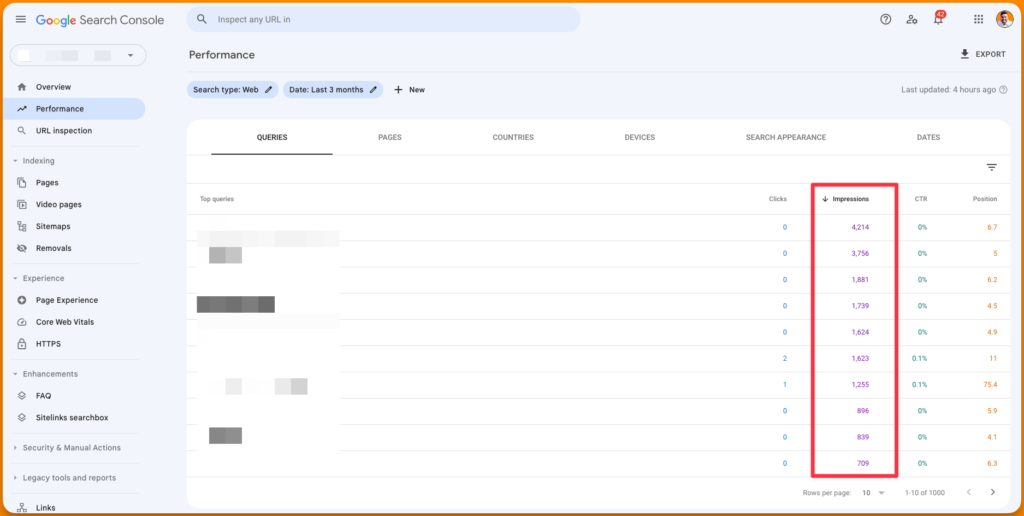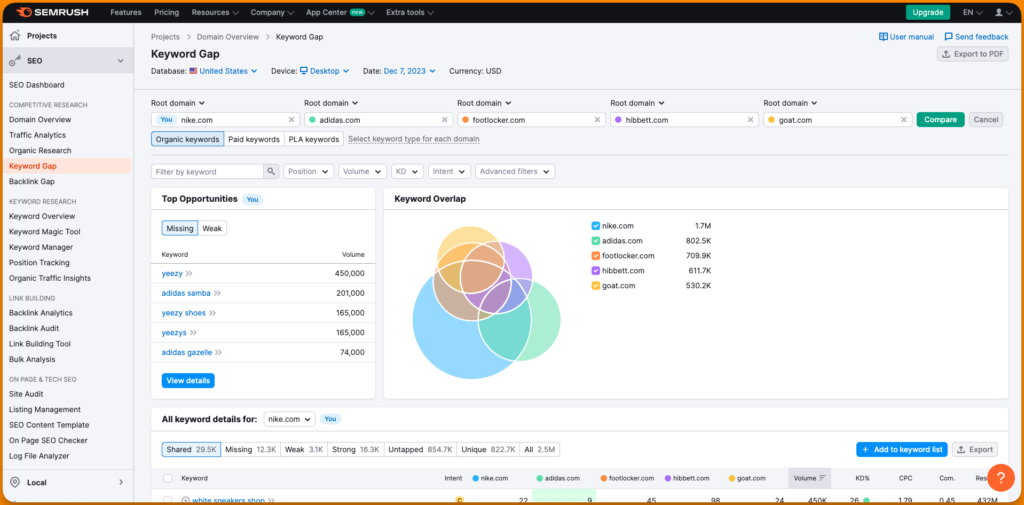The biggest hurdle in content gap analysis isn’t finding the gaps, it’s understanding why they exist. You can make your website highly relevant just by continuously looking for gaps you can fill.
- Attract relevant traffic
- Allocate resources effectively
- Build stronger brand & topical authority
What if the content you never thought to create could be the key to unlocking your website’s true potential? You’re one post away from hitting the jackpot on search engines. Nobody can orchestrate viral content, if someone promises you that, it’s definitely to fool and loot your money.
If you pay close attention to SERPs, you’ll see that certain keywords are dominated by a handful of sites. However, there are sites that outrank well-known sites for several search terms.
Most businesses that want to get exposure to SERPs make the mistake of creating content only around the topics that are directly relevant to the products/services they offer. This creates a huge gap that could land them in front of their audience for other relevant topics.
For example, as a web designing agency, one of your target audiences is photographers. Instead of creating content only around web designing, create content around the intersection of photography & web design that might land you in front of potential customers, in this case, photographers.
Topics like “best themes for photographers” or “Interactive photo gallery tools” qualify as content gaps that you should fill.
Content gaps are the blind spots that could potentially cost a fortune if not filled. Google prefers topical authority to rank sites at the top for search queries. Ignoring the content gaps might get you in trouble in terms of topical authority.
The existing efforts, time, and money that go into SEO of your business can be put to a halt if you don’t cover the unexplored topics. Ranking opportunities are hiding in plain sight, all you need to do is uncover them one by one.
Furthermore, by covering the gaps that you find using the methods mentioned here, you can create a go-to library of resources that your users can rely on for a very long time.
With that said, you can start filling the gaps in your content using the following simple steps:
Step 1: Understand why filling the content gaps is important
Speaking of the importance, there are a ton of reasons why you should aggressively invest in filling content gaps. More content means more interlinks, which further translates to tighter networks of relevant pages. This adds to your topical authority.
You’d have a competitive edge by covering a topic deep enough for the end users to choose you. Wikipedia ranks #1 for several keywords for a reason.
When it comes to diversifying the traffic, by covering more topics, you’re creating more opportunities to get in front of your audience. In terms of conversion rates, covering more topics will mean users have all their questions answered.
Imagine a knowledge base that answers questions and shows people how to use a tool. How effective is it to convert a free user into a paid one?
Another thing you can leverage by covering more topics is SERP features like featured snippets (answer boxes), local packs (maps), images/videos, and more. Some of the other variations of the keyword will rank and help you with the SERP feature.
One of the most important benefits of covering content gaps is aligning with the user intent. If you give it a thought, there can be several search intents for a single keyword (use AI to find all the search intents).
P.S. Filling gaps doesn’t mean just creating new content, updating the existing ones also matters.
Step 2: Conduct content gap audit manually
The OG method to find content gaps, both to update existing and create new content is using webmaster tools like Google Search Console and Bing Webmaster tools. In the performance report, look for the impressions data (sort high to low) as shown below.

Click one keyword you think is fruitful, then switch to the page tab to know the page the keyword can potentially send traffic to. Begin optimizing the page for that keyword. If the keyword is never used, it means Google is telling you that your page deserves ranking for the selected keyword.
How to optimize a page for the keyword?
- Optimize for relevance: When people search for certain keywords, they expect some specific results. Make the content relevant by talking about the scenarios that would trigger the need to search. For example, a user searching for “symptoms of food poisoning”
- Audit regularly: The best part of taking the impressions data is that you will get never a never-ending supply of keywords your pages can potentially rank for. Auditing will help you find opportunities for updating the content or adding new content pieces as part of topical authority.
- Demonstrate EEAT: You don’t have to have expert writers as authors. It’s good to have but there’s no written rule that only already already-established author should author the post. If you’re just starting out, get active on social media and get backlinks for your name. Slowly, your authority will rise.
- Match search intent: Optimize the page beyond keywords. Understand the search queries for the intent and optimize for it. For best results, optimize only for one intent, especially for commercial pages.
- Find semantic keywords: Semantic keywords ensure that the crawler isn’t confused about the context of the topic. When you write about Apple, semantic keywords help distinguish between the tech giant and the fruit.
Step 3: Find content gaps using these tools
Almost all keyword research tools have modules to find content gaps, SEMRush, Ahrefs, Ubersuggest you name it. I’ve used all three to find content gaps, the results are almost the same. What you’re used to will make the difference.
I’ve used Ubersuggest the most so I’d incline toward it. There’s no best tool or winner for this use case. However, if you need more data and insights into keywords and other fancy stuff, the recommendations become subjective.
SEMRush is the second best. I like how competitors get listed automatically. These competitors are closely related to the root domain you enter. You can always compare any domain with the root domain finding gaps.

With SEMRush, you can find deep insights related to the competitors you discover while finding gaps in your content. You can use the data related to your competition to find more opportunities in terms of PPC and sources of traffic.
Furthermore, in terms of backlinks, SEMRush can help you with a ton of data. Find who’s linking to any page on your competitor’s site. Use that data to find link-building opportunities.
Video Guide
You are creating content for your website, but you are not sure if you are creating the right content. You want to make sure that you are creating content that your target audience is interested in and that will help you achieve your business goals.
This video provides a solution to this problem. Learn how to identify the gaps in your content & fill them with new content that is relevant to your target audience and addresses their needs.
Today’s action steps →
- Go to Google search console & open the performance report
- Filter impressions data for the past 3 months high to low
- Identify new keywords to optimize your pages for
SEO this week
- Google launches Gemini. A ChatGPT Killer or nervous move?
- Google rolled out the November core update. The fourth this year
- Google now supports logos & URLs with structured data
- “Focus on user satisfaction, not on ranking on Google,” says Danny Sullivan
- While SGE is becoming a threat to SEOs, brands are blocking Google-extended
Masters of SEO
- Impact of Google’s SGE on SEO
- The patent behind Google SGE explained
- How to expand brand presence post HCU?
- Unlocking visibility on Google’s surfaces
- How big is Google’s index? 400 Billion, big
How can I help you?
I put a lot of effort into coming up with a single edition of this newsletter. I want to help you in every possible way. But I can do only so much by myself. I want you to tell me what you need help with. You can get in touch with me on LinkedIn, Twitter, or email to share your thoughts & questions that you want to be addressed. I’d be more than happy to help.
Whenever you’re ready to dominate SERPs, here’s how I can help:
- Sit with you 1-on-1 & create a content marketing strategy for your startup. Hire me for consulting
- Write blogs, social posts, and emails for you. Get in touch here with queries (Please mention you found this email in the newsletter to get noticed quickly)
- Join my tribe on Twitter & LinkedIn where I share SEO tips (every single day) & teaser of the next issue of Letters ByDavey

